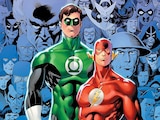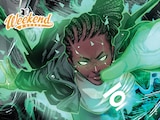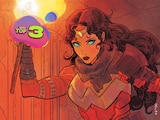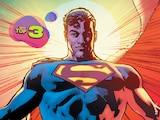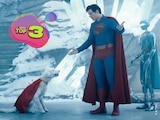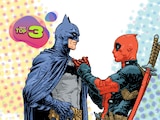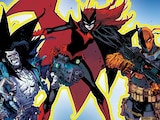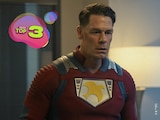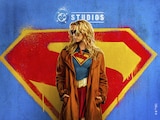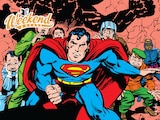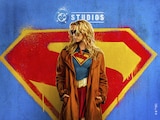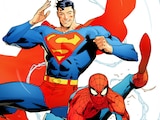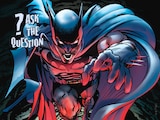Last year, DC: The New Frontier celebrated its 15th anniversary. It’s odd to think that the book is only turning 15, since it feels so timeless. Written and drawn by the late, great Darwyn Cooke in 2004, DC: The New Frontier is a love letter to the mid-20th Century and the spirit of American heroism and exploration. It takes the classic superhero ideal and juxtaposes it against America’s most idealistic era, creating a perfect synergy that just emanates love, affection and life. It’s one of the most vibrant comics of the modern age, and absolutely stands alongside other out-of-continuity classics like The Dark Knight Returns, Batman: The Killing Joke, Kingdom Come and All-Star Superman. It is, quite simply, one of the best books that DC has ever produced.
Our current pop culture climate is fixated on nostalgia. Sometimes this is a great thing. Sometimes it’s to the detriment of the art being created. In 2004 when New Frontier was first being published, the trend to tie all of our media to the past had not yet begun. Yet, DC—and the entire comic book industry—was built on the comics of the Golden Age, Silver Age, Bronze Age and each incredible story that predates the comics that are currently sitting on stands. In creating New Frontier, Cooke put his finger on what made DC superheroes great and birthed an epic standalone story from that realization.

It helped that DC had history on its side. With superhero stories reaching all the way back to the 1930s, New Frontier begins less than a decade after the birth of Superman in the pages of Action Comics and Batman in the pages of Detective Comics. It takes the same approach to the characters’ real-world origins that it does meta-narratively to the original source material. By offering readers a chance to observe Hal Jordan engaged in hand-to-hand combat on the fields of battle and Wonder Woman freeing a group of disenfranchised women from crushing oppression, we’re given a clear, direct path to understanding these iconic superheroes in a fundamental way that sometimes drifts to the wayside when you’re reading a story month-to-month in real time.
Origin stories aren’t a rare thing in comics, although a definite origin can be hard to come by, especially for characters who are not part of the Justice League. I’ve always appreciated that in New Frontier, Cooke gives an origin story to each and every important character. My hot take? The pages of New Frontier portray the very best Martian Manhunter origin that has ever been or will ever be.
If you have never read New Frontier, just check out the sequence where Martian Manhunter is watching television. If it doesn’t sell you on New Frontier and J’onn J’onzz in general, I just don’t know what to say to you, kid. It’s out-of-this-world brilliant!

New Frontier is a primer for everything that is pink and perfect about superheroes. It illustrates the Justice League at their very best when they have first come together and made the decision to make the world a better place. In fact, there are heavy Justice Society overtones throughout the book that diehard JSA fans are sure to delight in. The tone Cooke strikes is much closer to an Earth-2 JSA adventure or an early JLA adventure than any of the contemporary titles with the words Justice League in them.
To get a bit deeper, though, Cooke presents the real-world events these superheroes occupy and shows how by simply being who they are and standing up for what they know is right, their actions and example are enough to change the world. A superhero’s single greatest superpower is his or her ability to inspire, which is something Cooke seems to understand unequivocally. DC: The New Frontier is nothing if not a testament to that.

Cooke’s stunning visuals and classically inspired line art serve to illustrate what a uniquely North American medium comic books and superheroes actually are, but it’s also a very clear reason as to why this story was adapted into an animated movie in 2008. The movie is great in its own right—it’s one of the movies that helped cement DC’s reputation for quality animated films. However, New Frontier is DENSE. Due to time constraints, the movie simply couldn’t get into all the phenomenal detail of the comic book. Even if you’ve already seen the adaptation, I really can’t recommend enough that you take the time to read the film’s inspiration.
By celebrating these characters at their best—including portraying a Wonder Woman who is taller than Superman, which I love!—as we witness them transform into the superheroes that we love so much, New Frontier challenges us to understand the roots of heroism on this scale. By association, it also lays clear how we can take inspiration and make these same changes in ourselves and in our lives. And this is to say nothing of Cooke’s incredibly, transcendent art style which feels at the same time retro and extremely contemporary and high concept. Simply put, New Frontier is comics at its best.
DC: The New Frontier by Darwyn Cooke is available through DC Black Label wherever books and comics are sold. It's also available digitally. For more on the book, be sure to check out Tim Beedle and Amy Ratcliffe's readthrough.
Ashley V. Robinson writes about TV, movies and comics for DCComics.com and is a regular contributor to the Couch Club, our television column. You can find her on Twitter at @AshleyVRobinson and on the Jawiin YouTube channel.

